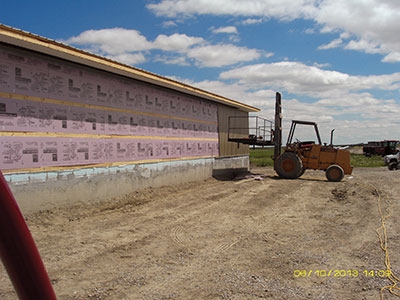
Levi Hofer – Alberta
By Yvonne Dick
Features Bird Management Production Business/Policy Canada Poultry Production Production ProfilesHappy birds, happy manager at the New York Colony
 Viega foam insulation, installed inside and between the building’s girders, will help regulate temperature. Yvonne Dick
Viega foam insulation, installed inside and between the building’s girders, will help regulate temperature. Yvonne DickNew York Hutterite Colony member Levi Hofer has more than just the 120 residents on the farm to think about during daily life – he is also a dad to a large flock of prime egg-laying chickens. At the moment, his main focus is on the new pullet barn. As the egg manager, Hofer is responsible for the well-being and husbandry of all 8,000 egg-laying birds – including their entertainment!
“Enriched cages have scratch pads where the birds can have some fun playing and scratching. It gives the birds more to do during the day than just stand in the house and look out. If the bird is happy, so is the manager!” Hofer says.
The new pullet barn, built to house up to 12,000 birds, will be completed this fall. The cages in the new barn will allow the birds to nest, perch at night to sleep and live in more natural surroundings. Viega foam insulation, in the form of polystyrene grid fastening (insulation value R-5) inside and between the building’s girders, will mean a cooler barn in summer and a warmer, more consistent temperature next fall and winter.
The barn is being built from the ground up, as the existing barn was somewhere around 30 years old. Although serviceable, the cages were deteriorating, and Hofer wanted to experiment to develop the optimal housing and laying conditions for the birds. In fact, he went all the way to California to see how farmers there had their barns set up.
California doesn’t have the winter heating expense of Alberta, but their barns still need to keep heat out in the summer. The main thing Hofer took back to New York Colony was a tiered catwalk system for walking around the barn – a feature the new barn will have that will also be the first tiered catwalk barn in Canada. For summer heating issues, LEDs will replace incandescent lights, due to the fact that LED lights do not throw off large amounts of heat when turned on. This will save in energy consumption and cost, which translates into more money for winter heating ideas.
“Our old barn had a range of lux – it could be five to 10 lux, and in between lights it might be as low as two lux sometimes. I did a trial of one year for the LED lighting. I found that it relaxes the birds, keeps them calmer and it is definitely more energy efficient,” says Hofer.
Another way the barn will be energy efficient is in the heating system itself. The new barn will have two-stage heating: The first stage will heat to 240 F with overhead water pipes, while the other will be in-floor heating at 210 F. The systems will cycle back and forth so that when one stage of heating is at its maximum temperature, it will cool down while the other kicks in.
Managing the birds’ weight, health, light, heat and growth during the first 19 weeks is critical, says Hofer. If not off to a good start before week 20, adult birds in the laying barn will have a lot of trouble adjusting and be less likely to lay eggs on a consistent basis. Consistency, while good for hens, is not always the best when it comes to barn management – sometimes, new concepts are just what a farmer needs.
“As a director on the egg board, I’m involved with the new changes that we see in our industry. It’s not just about the egg anymore or the farm; it’s more about the hen and the environment – the energy efficiency of producing the egg and the health of the bird,” says Hofer. “It’s not about me, it’s about the bird and the flock. Finding what the flock needs, making the flock and the bird more comfortable.”
But comfortable farming conditions can sometimes require a little help, says Hofer. “I feel very thankful that we have a supply management system on eggs that gives farmers the opportunity to restructure a facility to meet the new environment of the near future. Also, I’m thankful of the government’s support with the Growing Forward 2 program – for the help with funding of the bulbs and the floor heating and insulation on the outside. We have a great country and we should be thankful of what we have.”
He credits the colony’s residents for their support and forward thinking.
“Nowadays on the farm you can’t have short-term thinking, you have to go with long-term thinking – up to the next 30 years. We’re meeting the standards of the new generation and technology for the future of egg farming,” he says.
Print this page